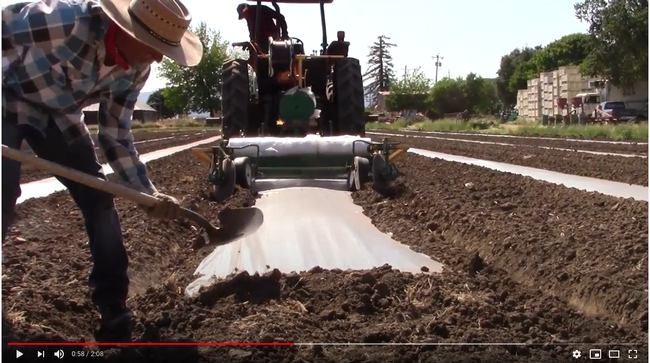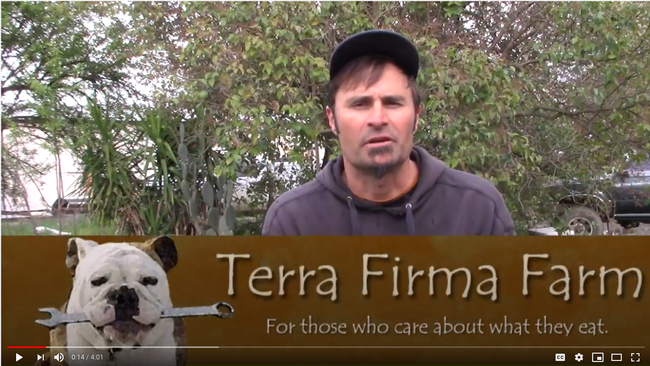The days are long and the temperatures are high. This is a great time to solarize the soil in the Central Valley as a way to manage annual weeds and improve the growth of fall crops.
What is solarization? A non-chemical approach to weed control, soilborne pest management and soil enhancement using solar heating of plastic-covered moist soil. This method allows the sun's radiant energy to be trapped in the soil thereby heating the upper levels, killing and/or suppressing soil pests.
Watch video here: Clip of laying plastic with a tractor for soil solarization.
Why solarize?
- Kills or weakens many crop pests such as plant pathogenic bacteria and fungi, insects, nematodes and weeds within 2-12 inches +/- of the soil surface
- Soil physical and biological benefits
? Increases levels of soluble, mineral nutrients available to the subsequent crop (nitrogen in the form of ammonium and nitrate, calcium, magnesium)
? Generally less lethal to beneficial microbes than to plant pests
? Increases breakdown of organic matter
? Improves soil tilth
- Effects often last for multiple seasons, though best effects are directly after solarization
- Can work in combination with other pest management techniques such as steam, hot water, fumigants and pesticidal chemicals, biological controls, organic amendments (“biosolarization”), and host resistance
Watch video here: Paul Underhill discusses how has used soilsolarization
Solarization Factors:
Temperature: Solarization should be done in the warmest part of the summer. Usually this is between June and August in California. (See http://ucanr.edu/sites/solarization/california_air_temperature_maps/ for average temperatures for different months and locations in California.)
Timing: 4-6 weeks for maximum benefits (even 1-3 can provide some effects; time may be reduced with combinations such as biosolarization)
Soil preparation: Soil should be as smooth as possible to get maximum soil-plastic contact. This can be achieved by finishing with roller or bedshaper, or working the soil by hand and removing any large debris or clumps.
Plastic*: The most commonly used plastic is transparent polyethylene. Optimal thickness is 025-.03 mm unless solarization is being done in a particularly windy or animal-trafficked environment, in which case slightly thicker plastic should be used. Infrared-transmitting plastic can be purchased to facilitate a slightly higher temperature increase. Plastic with additives to decrease brittleness-causing sun damage can also be purchased.
Moisture: Soil moisture should be at 70% of field capacity in the upper layers of the soil and moist up to 24 inches deep to obtain maximum benefits. It should crumble easily when squeezed. When moistened prior to plastic, soil should be covered as soon as possible to avoid evaporation. When done after, water can be added via drip lines, furrows or hose pipe outlets under the plastic.
Beds: Plastic can be laid in strips over beds (min. 30” beds) or continuously for complete coverage. Strip coverage tends to be less effective than complete coverage because there is a cooling effect on the edge of the beds. For complete coverage, plastic can be installed by hiring a custom applicator, or can be laid in strips and joined by glue.
Bed specifications: For strip solarization, wider bed tops will accumulate more heat. It is best to solarize on strips with north-south orientation rather than east-west, to minimize shading. Beds with no slope or a slight south-facing slope will yield optimal results.
Plastic placement: Plastic can be lain by machinery or by hand. It is important that the edges of the plastic are buried.
Repair: If tearing occurs, plastic can be patched with patching tape.
Possible Disadvantages:
- Challenges associated with plastic disposal
- Perennial weeds, bulbous weeds, and seeds with a hard seed coat are harder to control
- Climate factors, such as fog and wind, may impede solarization
- May decrease root nodulating rhizobial bacteria in the soil
- May increase purple nutsedge under certain circumstances
Further information:
Check out videos, how-to and the science of solarization here.
* Plastic can be sourced locally from Irrigation Supply Co. in Woodland. The price is $137.14 for a 60” x 4000' x 0.001” roll. Plastic is usually in stock, though should be ordered several weeks to months in advance for large orders.
|
Short List of Pests Controlled by Soil Solarization (for a complete list, visit references) |
|||||
|
Plant Diseases |
Nematodes |
Weeds |
|||
|
Fusarium Wilt (tomato, cucumber, strawberry) Pythium, seedling disease Phytophthora root rot Rhizoctonia, seedling disease Verticillium Wilt |
Corky Root (tomato) Lettuce Drop White Rot (Garlic and onions) Southern blight Black root rot (many crops) Crown gall (many crops) Canker (tomato) Scab (potato) |
Ring Stem and bulb Potato cyst Northern root knot nematode Lesion nematode Citrus nematode Dagger nematode |
Velvet leaf Pigweed Fiddleneck Wild oat Black mustard Shepherd's purse Lambsquarter Miner's lettuce Field bindweed (seed only) Horseweed Large crabgrass |
Barnyardgrass Goosegrass Henbit Cheeseweed Branched broomrape Bermuda buttercup Annual bluegrass Purslane |
Common groundsel Prickly sida Black nightshade Hairy nightshade Sowthistle Common chickweed Horse purslane Common cocklebur |
|
Short List of Pests Unpredictably Controlled by Soil Solarization |
|||||
|
Diseases |
Nematodes |
Weeds |
|||
|
Charcoal Rot (many crops) Bacterial wilt |
Southern root knot nematode |
Field bindweed Bermudagrass Yellow nutsedge |
Purple nutsedge Lovegrass Bull mallow |
White sweet clover Johnsongrass |
|
References:
Elmore, C.L., Stapleton, J.J., Bell, C.E., & Devay, J.E. (1997). Soil Solarization: A Nonpesticidal Method for Controlling Diseases, Nematodes, and Weeds. (Publication No. 21377). Oakland: University of California Agricultural and Natural Resources.
Stapleton, J.J. (n.d.). Solarization for Vegetable Weed Control. California Weed Science Society. Retrieved from http://www.cwss.org/uploaded/media_pdf/59-67_2007.pdf
Yaduraju, N.T., & Mishra, J.S. (2004). Soil Solarization: An Eco-Friendly Approach for Weed Management. In Inderjit (Ed.), Weed Biology and Management. (1st ed., pp. 345-362). Dordrecht, Netherlands: Springer Science + Business Media.

